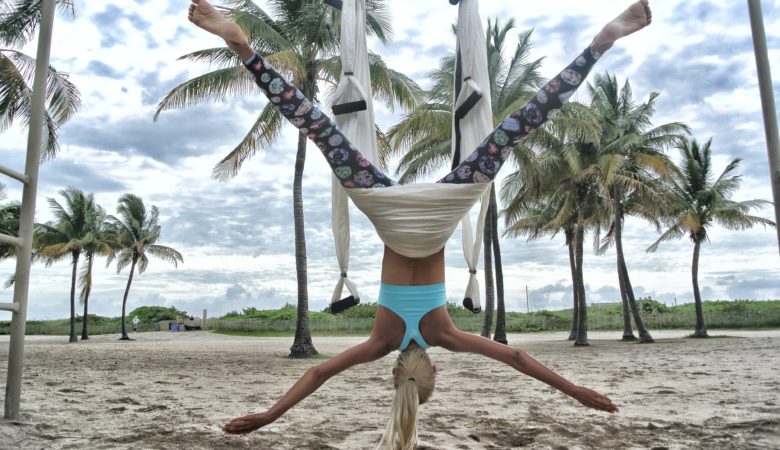What is Anti-Gravity Yoga and Why is it Gaining in Popularity?

Strength, flexibility, inner peace… and hanging from the ceiling? If you try anti-gravity yoga, you could experience all of these things at once. This combination of yoga, pilates and aerial silks is a great way to improve your flexibility and build strength. Those are benefits that more traditional forms of yoga already offer. So why do people love this new variation so much?
More than sheer novelty (and it is pretty novel), anti-gravity yoga offers a few unique benefits in a different package. Hanging from the ceiling tends to give your body a different kind of working than one where your feet (or other body parts, as the case may be) are planted firmly on the ground. Here’s why anti-gravity yoga is gaining in popularity.
How it works
Anti-gravity yoga is performed with the help of “hammocks,” which are suspended from the ceiling. Some poses have students “flying,” while others might see them hanging upside down like a bat. These strength and flexibility exercises, along with the hammock, help students achieve more intense or unusual poses that wouldn’t be possible on the ground.
According to VeryWell Fit, “Using the hammock, you learn to invert and hang suspended in the air. The hammock supports your hips for forward bends and backbends. It acts as your seat for any number of variations on the ab-tastic crunch. It can be looped around one foot,” or you might use it to support your body during savasana.
If you want to get technical, anti-gravity yoga isn’t strictly yoga. It borrows yoga poses, and there’s a strong mind-body-spirit focus, but it also uses Pilates and other exercise methods to promote toning in mid-air.
Suitable for any fitness level
Anti-gravity yoga has been around since 2009, but it has recently become even more popular throughout the world. Part of that is because of its novelty, but another facet is that it’s suitable for any fitness level. Creator Christopher Harrison said, “I created it so even my mother can do it.” Anti-gravity yoga instructor Heather Blair agrees that anyone can do anti-gravity yoga. “You literally can be of any fitness level. You can have injuries. It doesn’t matter how old you are—anyone can take the class.”
Traditional yoga is also good for various fitness levels: poses can be adjusted to accommodate injuries and other limitations, or you can increase the stretches to get a better workout. Anti-gravity yoga is simply another version of this concept. In many cases, practitioners believe it gives an even better workout.
Spinal decompression
If you’ve got back pain, anti-gravity yoga might be the next best thing to a Thai massage. Being suspended from the ceiling helps the spinal column decompress. The force of gravity allows your vertebrae to separate and almost “unclench.” As you hang upside down, space opens up between your vertebrae, which allows blood and spinal fluid to circulate better.
You might get a little dizzy—that’s common for new anti-gravity yogis. However, that should quickly pass after the session, and most people report improvements after a few classes.
Cardiovascular benefits
The other big benefit is that anti-gravity yoga tends to get your heart rate up more than traditional forms of yoga. The cardiovascular workout stems from getting up (and down) in the hammocks: it takes a lot of effort to perform the poses. In some cases, the poses include repetitive movements that work the heart just as much as the core, arm and leg muscles. So yes, you’ll burn more calories during an anti-gravity session, although it might not be quite as peaceful as other types.
Ready to try your first session?
If you’re thinking about trying your first anti-gravity session, there are a few tips to make it easier. First of all, do it on an empty stomach. Inversions can make anyone nauseated, and most teachers recommend eating afterwards.
Second, wear long sleeves and pants to decrease the possibility of “rope” burn. (Hammock burn?) You might notice that your hands are cramped or sore afterwards from hanging on to the hammock—that’s normal.
Finally, make sure that you consult with your medical doctor before trying a class. Certain health conditions, like glaucoma, can be exacerbated by this type of exercise.
Once you have these items squared away, you’re free to perform yoga in the air to your hearts’ content. Will you try this popular new form of exercise, or keep your feet on the ground?

